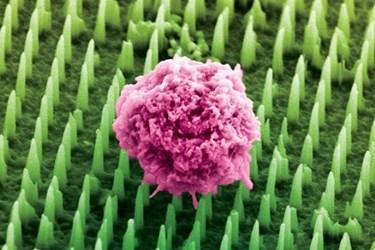Nanoneedles Deliver Genetic Material Into Cells, Could Promote Vascular Growth

Scientists have developed tiny nanoneedles that inject nucleic acids into cells and stimulate vascular growth in mouse models. Among many possible indications, researchers believe their new technique could help the body repair itself and reduce the risk of organ transplant rejection.
The Imperial College London (ICL) and Houston Methodist Research Institute (HMRI) collaborated on the study, which investigated a new method of delivering DNA and siRNA that was more scalable and less toxic than previous methods. According to a press release issued by the two organizations, the approach could allow scientists to reprogram cells and change their functions.
“This will let us personalize treatments for each patient, give us endless possibilities in sensing, diagnosis and therapy,” said Ennio Tasciotti, co-chair of the department of nanomedicine at HMRI.
The team’s technique, outlined in a study published in Nature Materials, uses an array of porous and biodegradable silicon nanoneedles to inject nucleic acids into the cell. The needles’ size greatly reduced risk of cell damage or death, and the material’s porosity allowed for a larger payload of genetic material. In the study, the silicon disappeared after two days, leaving a residue of orthosilicic acid, a nontoxic substance.
The team performed in vitro experiments with the nanoneedles, and found that they could access cytoplasm and deliver DNA and siRNA “with an efficiency greater than 90 percent,” said the study authors.
“This is a quantum leap compared to existing technologies for the delivery of genetic material to cells and tissues. By gaining direct access to the cytoplasm of the cell, we have achieved genetic reprogramming at an incredibly high efficiency,” Tasciotti said in the press release.
The researchers also tested the nanoneedles in the back muscles of mouse models and found that the technology induced vascular growth and a sixfold increase in blood perfusion after a week of treatment. Blood vessels continued to grow for 14 days after the treatment had concluded.
Molly Stevens, professor of materials and bioengineering at ICL, said that while the research was in its very early stages, the team believes the technology has “enormous potential for helping the body to repair itself.”
In the future, researchers said that the nanoneedles could ease organ transplants by stimulating the body to grow its own vascular connections to the new tissue. Ciro Chiappini, first author of the study and a professor in the department of materials at ICL, said the technology could also be developed into a bandage that heals wounds with functional tissue rather than scar tissue.
“If we can harness the power of nucleic acids and prompt them to carry out specific tasks,” said Chiappini, “it will give us a way to regenerate lost function.”
Image credit: Imperial College London
